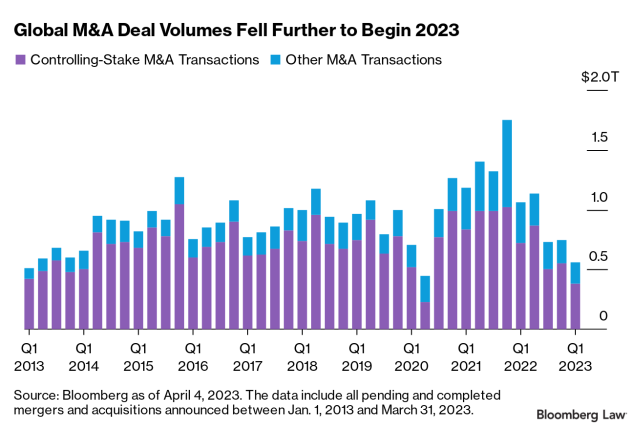Getting to a Close – Increased Use of Deferred Compensation in an Uncertain M&A Market

As interest rates, banking turmoil, and overall economic headwinds continue to pose financing pinches, private equity dealmakers are increasingly pivoting to deferred or performance-based compensation to close transactions. In particular, private equity buyers have turned to earnouts and seller notes to help bridge growing valuation gaps created by unfavorable lending markets. With the 2023 deal volume continuing to underwhelm, private equity buyers may continue to utilize these compensation structures in response to an uncertain market.
2023 Market Review
After a challenging end to 2022 that was defined by macroeconomic factors, including the global impact of the Russia-Ukraine conflict and general supply-chain disruption, it was easy for pundits to predict an increase in merger and acquisition volume in 2023 globally. However, Q1 2023 had the third lowest global quarterly merger and acquisition (M&A) volume in the last 10 years – beat out only by Q1 2013 and early-pandemic Q2 2020.

While some predict that the second half of 2023 may provide a positive bump in deal work, it would be fair if buyers and sellers remain guarded in such teetering economic conditions.
Earnouts and Seller Notes
In addressing the pinch on financing and market uncertainty, private equity buyers have turned to provisions known as earnouts. These allow buyers to defer a portion of the purchase price and make the remaining payments only if and when the purchased company meets certain milestones. Those milestones could be based on a multitude of operational or business-relevant achievements, such as hitting earnings targets or obtaining regulatory approval.
According to SRS Acquiom’s 2023 M&A Deal Terms Study, in 2022 there was an upward shift in earnout structures in transactions, increased use of earnings or EBITDA-based metrics for purposes of calculating earnouts, and longer performance periods when calculating earnouts.
An alternatively popular structure has been the seller note. This is where the buyer pays a portion of the purchase price upfront at closing and issues a promissory note to the seller(s) for the remainder of the purchase price. This form of debt is typically subordinated to the buyer’s senior debt and provides lower than market interest rates. Like earnouts, a seller note reduces the amount of cash needed at close for a buyer.
A different economic climate is influencing the M&A market, which has resulted in the increased use of earnouts and seller notes. With buyers facing more challenges in accessing leverage from banks and nonbank lenders, more buyers are turning to earnouts and seller notes to bridge this funding gap. While earnouts and seller notes are potential financing alternatives, it is important for buyers and sellers to understand the nuances of these alternatives.
In This Article
You May Also Like
Important Reminder on Director Independence Under the MFW Framework Federal Trade Commission Bans Noncompetes